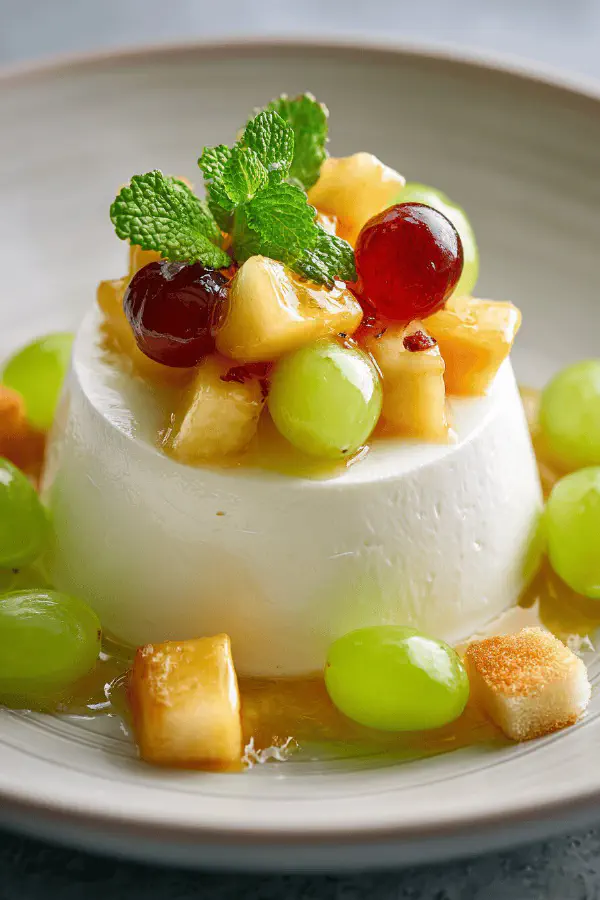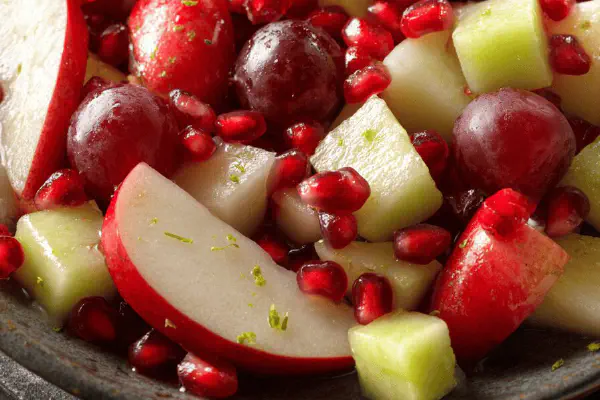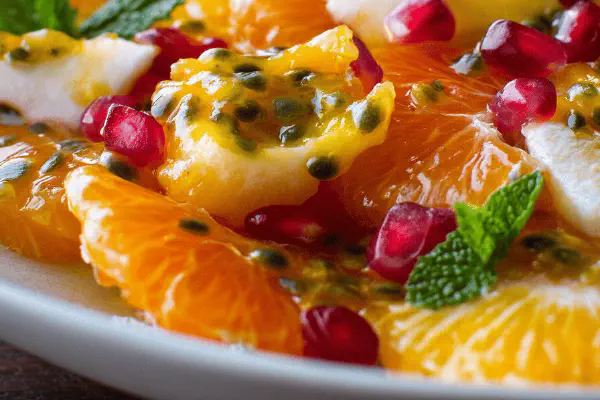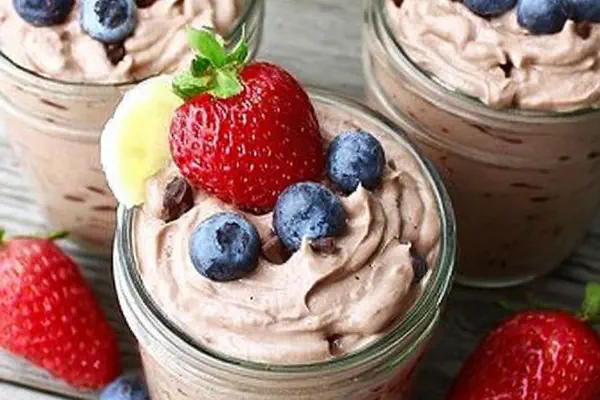Featured Recipe
Light Yogurt Mousse with Fruit Salad

By Kate
"
A lighter mousse using Greek yogurt and gelatin, paired with a fresh fruit medley sweetened with honey. Adjusted ingredient ratios for balanced texture. Egg whites whipped to soft peaks and folded gently keep mousse airy but stable. Substituted lemon zest for juice to cut harsh acidity. Replaced kiwi with mango for subtle tropical notes. Sautéed apple slices add warm caramel aroma, boosting flavor depth. Gelatin bloom time and incorporation crucial for smooth gel. Chill long enough to set but not overly firm. Fruit tossed right before serving to maintain freshness and color. Simple, versatile dessert with practical tweaks suitable for daily cooking.
"
Prep:
35 min
Cook:
10 min
Total:
330 min
Serves:
4 servings
dessert
healthy
mousse
fruit
yogurt
Introduction
Start with gelatin blooming — essential. That jelly texture tells you all you need. Lucky if you spot clumps; otherwise curse surprise lumps later. Yogurt heat stage demands close watching — yogurt’s temperament is fickle. You want steam flirting edge but no bubbles popping loud. Sensitive proteins scramble easy. Egg yolks—whisk till pale and airy, ribbon forming. That’s your light base. Whites whipped just to soft peaks hold air but stay tender; stiff peaks become concrete irreplaceable mistake. Folding mousse? Gentle doesn’t mean slow; no aggressive stirring or volume dies. Chill in clear glass for judgement– jiggle test not clock. Fruit on top: fruit, fresh and alive. Apple warmed a touch makes caramel scent whisper in kitchen. Mango instead of kiwi avoids sour surprise. Serve fast; fruit wilts fast. Layered textures, balanced sweetness, tactile cues make difference.
Ingredients
Yogurt Mousse
- 7 ml (1 1/2 tsp) gelatin powder (bloomed)
- 20 ml (1 1/3 tbsp) cold water
- 275 ml (1 1/8 cups) Greek yogurt 5%
- 10 ml (2 tsp) lemon zest finely grated
- 5 ml (1 tsp) pure vanilla extract
- 2 large eggs room temperature separated
- 60 g (1/4 cup) caster sugar
- 15 ml (1 tbsp) honey or light agave syrup
- 1/2 ripe mango peeled, cut into thin half-moons
- 1 small apple peeled, cored, thinly sliced
- 125 g (3/4 cup) seedless green grapes halved lengthwise
- 5 ml (1 tsp) finely chopped fresh mint
- 10 g unsalted butter
Fruit Salad
About the ingredients
Gelatin quality varies; avoid over-blooming or under-dissolving to prevent gritty mousse. Greek yogurt lowers fat from original whole yogurt; yields lighter but still creamy base. Substituting lemon juice with zest controls acidity—less protein disruption thus custard smooth. Eggs must be room temperature — cold eggs don’t whip well and may cause curdling during mixing. Avoid overbeating whites; dry meringue causes stiff texture and inhibits mousse aeration. Butter-sautéed apple introduces warm aromas, enhancing fruit salad depth without extra sugar—an old trick to balance acidity from raw fruits. Mint finely chopped releases fresh oils; avoid bruising. Honey replaces maple syrup; a classic swap that maintains natural sweetness with floral undertones. Fruit size uniform for consistent mouthfeel, gentle folding avoids juice mixing into mousse layer prematurely.
Method
Fruit Preparation
- 1. Heat butter in a skillet over medium. Toss in apple slices. Stir gently until edges start browning and aroma comes off, about 3-4 minutes. Remove and cool slightly. This adds caramel notes and softens texture, preventing raw harshness.
- 2. In mixing bowl, combine mango, browned apples, grapes, honey, chopped mint. Stir carefully to avoid bruising fruit. Set aside at room temp until mousse ready.
- 3. Bloom gelatin: sprinkle gelatin evenly over cold water. Let stand 7 minutes until surface is lumpy but jelly-like and fully absorbed. Avoid clumps; sifting gelatin powder before can help.
- 4. In small saucepan, warm 70 ml (just under 1/3 cup) yogurt with lemon zest and vanilla over medium heat. Watch carefully—when tiny bubbles form at edge, remove immediately. Don’t let boil or curdle. Visual cue: steam rising, yogurt thinning.
- 5. Stir gelatin into warm yogurt mixture until fully dissolved. Gelatin consistency changes here will show no grit or lumps. If not dissolving smoothly, continue gently warming bowl over barely simmering water, stirring constantly to prevent cooking eggs later.
- 6. Whisk remaining yogurt and egg yolks in large bowl until homogeneous, pale in color with fine ribboning when lifted. This aeration prevents dense mousse.
- 7. Slowly pour gelatin-yogurt mix into yolk mixture, whisking steadily. If added too fast, yolks cook (scramble). Keep temperature controlled; lukewarm at most.
- 8. In separate clean dry bowl, beat egg whites with electric mixer on medium speed until foamy. Gradually add sugar while beating, increasing speed to high. Stop when soft peaks form that hold shape but still tip over. Too stiff breaks mousse structure; too soft won’t hold air.
- 9. Using flexible spatula, fold one-third of meringue gently into yolk-yogurt. Don’t overmix or deflate—stop as soon as no white streaks remain. Repeat folding in two remaining portions carefully. Maintain volume by folding under, not stirring vigorously.
- 10. Spoon mousse evenly into 4 dessert glasses or bowls (~185 ml each). Cover with plastic wrap touching surface to prevent skin formation.
- 11. Refrigerate minimum 3.5 hours or overnight for best set. Texture should hold shape when spooned but softly jiggle. Overchilling makes mousse too firm.
- 12. Just before serving, spoon fruit salad over mousse. The fresh fruits add contrasting textures and slight acidity balancing the creamy mousse.
- If gelatin not fully dissolved: warm bowl gently, stir vigorously.
- Using lemon zest instead of juice gives brightness without toughening mousse proteins.
- Substitute mango with peeled peaches or nectarines depending on season.
- If avoiding raw eggs: pasteurized eggs or meringue stabilized with cream of tartar can be used.
- If mousse seems too runny after setting, fold in extra stiff whipped cream before chilling next time.
Mousse Base
Egg Yolks and Yogurt
Meringue
Assembly and Chill
Serving
Notes and Tips
Technique Tips
Bloom gelatin thoroughly for even texture; uneven gelatin pockets ruin mousse consistency. Warming yogurt mixture is temperature sensitive; pull pan immediately when steam is visible at edges—boiling causes curdling. Combine gelatin promptly to prevent clumps; if lumps appear, strain or gently reheat bowl in water bath to smooth. Whisk egg yolks with yogurt to aerate; good ribbon formation signals incorporated air crucial for mousse rise. Beat egg whites progressively adding sugar ensures stable meringue without grainy texture; monitor closely for peak stage rather than strict timing. Folding meringue in batches preserves volume; fold under spatula, rotate bowl, avoid overmixing. Portion mousse before chilling; individual glasses cool faster and help portion control. Chill at least 3 hours until set; texture should wobble slightly but hold shape to tell when ready. Toss fruit salad just before plating to prevent juice runoff and sogginess. Sauté apple releases Maillard aromas; watch caramel color darken but avoid burning or bitter notes.
Chef's Notes
- 💡 Gelatin bloom doesn't wait. Cold water—let it sit. No clumps; sift first. Hot yogurt mix, watch for steam. Small bubbles on edges. Keep stirring. A tight watch prevents curdling.
- 💡 Egg yolks need air. Whisk until pale, ribbon forms. Same with whites; soft peaks—not stiff. Gradual sugar. Whip for stability. Divide meringue folding slowly. Avoid losing volume.
- 💡 Mousse vessels must be clear; chilled even better. Wobble test is vital; jiggle but don’t spill. Refrigerate min 3.5 hours to set. Overdo it? Firm, not creamy. Adjust timing.
- 💡 Apple sauté—aroma rich, adds warmth. Keep the browning light. Caramel whispers, don’t burn. Mint fresh when chopped, avoid crushing. Toss fruit right before serving; sogginess ruins textures.
- 💡 If mousse isn’t setting right; fold in whipped cream. Check gelatin—maybe it clumped? Adjusting temperatures is key. Meringue must hold—if too dry, it ruins light texture.
Kitchen Wisdom
What if gelatin isn't dissolving well?
Warm it gently; stir well. Lumps appear, don’t panic. Strain to eliminate. Room temp, don’t rush.
Can I replace the egg whites?
Use whipped cream—fold in gently. Or opt for pasteurized eggs. Maintaining texture crucial, watch out for overbeating.
How do I store leftovers?
Fridge only, max two days. Cover to avoid drying. Trying to freeze? Consider the texture; might change too much.
What fruits can I substitute?
Peaches work well; nectarines can shine too. Change herbs; basil instead of mint? Sure, depends on taste.



